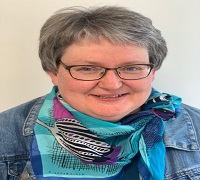Day :
- Nanomedicine & Nanobiotechnology, Advanced Nanomaterials- production, Synthesis and Processing, Nano patterning, Nano Lithography & Nano Imprinting, Graphene and Applications, Bio-Nanomaterials and Biomedical Devices, Applications, Nanotechnology & Energy, Medicinal Chemistry and Drug Discovery, Applied Medicinal Chemistry, Applications of Mass Spectrometry, Fundamentals of Mass Spectrometry, Frontiers in Chemistry
Location: Webinar
Session Introduction
Sari Ramo
Natural Resources Institute Finland (Luke), Finland
Title: Development and validation of a UHPLC-MS/MS method for the analysis of mycotoxins in onion
Time : 11:00-11:30

Biography:
Sari Rämö (M.Sc.) is the first year PhD student in PCS program at the University of Turku and works as a research scientist in Natural Research Institute Finland (Luke). She has over 20 years experience about mycotoxin analysis in cereals by gas chromatography - mass spectrometry(GC-MS). She has focused on analysing mycotoxins in onion and grass silage by liquid chromatography - mass spectrometry (LC-MS) during last five years. She has published 20 peer-reviewed scientific articles, the last one about Fusarium-toxins in onion. Her supervisor, Satu Latvala (PhD) has studied Fusarium fungi in different plants by molecular biology methods.
Abstract:
The Fusarium species causing Fusarium basal rot (FBR) in onion may also produce mycotoxins that are potentially harmful to humans and animals. The main mycotoxins produced by Fusarium oxysporum and Fusarium proliferatum are beauvericin (BEA), moniliformin (MON) and fumonisins B1, B2 and B3 (FB1, FB2 and FB3). A multiple reaction monitoring technique with ultra-high performance liquid chromatography tandem mass spectrometry (MRM UHPLC-MS/MS) for onion matrix was established to study these mycotoxins in the harvested onions. In the in-house validated protocol the onion samples were extracted with methanol:water (3:1) using magnetic stirring for 15 minutes. No cleanup of extracts was needed prior to analysis. The target mycotoxins were separated on an Acquity UPLC system BEH C18 column with gradient elution. Mycotoxins were identified and quantified using 13C-FB1 as internal standard. FBs and BEA were determined directly from the filtered extracts by ES+ ionization with at least two MRMs whereas MON required sample concentration prior to analysis and ES- ionization with one usable MRM. Minor matrix effect was compensated using multipoint matrix-matched calibration curves with uninfected onion sample. For the mycotoxins studied, a good linearity was obtained (R2≥ 0.99) and the recoveries were in the range of 67-122%, with the highest standard deviation for MON, 22%. The limits of quantification were from 2.5 to 10 ng g-1 in onion matrix. The method was successfully employed for the analysis of mycotoxins in harvested onions showing FBR symptoms and found to be infected with F. oxysporum and F. proliferatum.
Valentyn Nastasenko
Kherson State Maritime Academy, Ukraine
Title: On the possibility of combating covid-19 by the method of resonant vibrations

Biography:
Valentyn Nastasenko, Kherson State Maritime Academy Ukraine, faculties’ Engineering and electronics, the department of transport technologies and mechanical engineering. Dr. technical sciences, Professor. A sphere of scientific interests includes quantum physics, the theory of gravitation, fundamentals of the material world and the birth of the Universe, the author of more than 70 scientific works in these spheres.
Abstract:
The SARS-CoV-19 coronavirus pandemic poses a threat to all of mankind, and this threat is currently constantly growing. Recently, many mutations of the virus have appeared that are more aggressive and harmful than its original strains. At the same time, they are constantly and very quickly updated.
Vaccination does not solve all problems. It can provide individual protection for a person, but it does not allow the virus to be destroyed in the environment, even with the development of herd immunity in â…” of the world's population (about 4…5 billion people). This immunity has a limited duration, which requires re-vaccination. New mutations of viruses also require new vaccinations. Therefore, constant development of new vaccines is required, which is mainly of carried out in the catching up, with new strains in outstripping of them. This leads to local periods of lack of immune protection in people, the fight against which is possible only by introducing restrictions that are unfavorable both for residents and for the economy of all countries of the world.
This process becomes endless and requires the involvement of new intellectual, labor and material and technical resources, which are diverted from other important areas of the development of human life and activities.
Disinfection with chemicals and ultraviolet light can destroy of virus, but they also have their drawbacks and limitations in their application. For example Disinfection with ultraviolet light (quartzing) kills everything of total cells. Including cells of our body have damage. Therefore, at the time of its holding, everyone must leave the premises. Including the person, with is carrier of COVID-19 viruses. When he returns to this room, quartzing will be useless. A similar problem arises when using chemical disinfection. Therefore, the destruction of COVID-19 must be constantly.
Hence, it is necessary to search for new more effective ways, which is an important and urgent scientific and practical task posed in this work. It is based on the phenomenon of resonance, leading to an abrupt increase in the amplitude A of forced vibrations of a system, when the frequency ω of the external influence of vibrations on them approaches any of their natural vibrations ωо. The phenomenon of resonance is widely used in engineering for the mechanical destruction of materials and structures created from them. Vibrational resonance effects on bacteria and viruses are also possible. Modern nanotechnology makes it possible to create such devices in the form of medallions or microchips of mobile phones. Extensive research is needed in this area.
